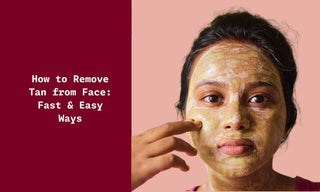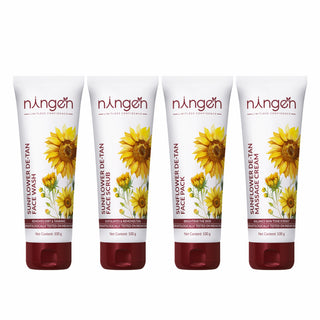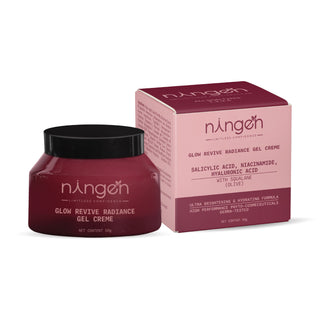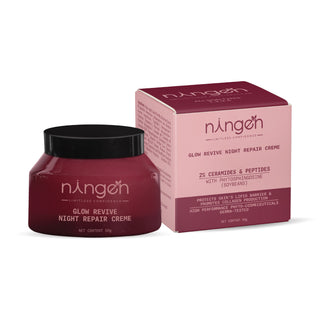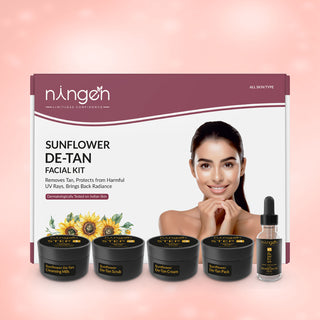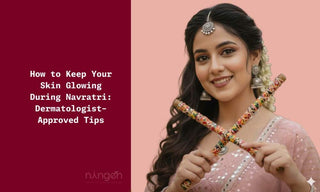"In the sun's light, we find beauty and caution, a balance necessary to preserve our skin's health."
No one can avoid the sun when we go out, or even when we're simply at home. Day by day, harmful rays affect our skin without our awareness, leading to unwanted tanning and skin damage. But with simple and easy methods, we can prevent and protect ourselves from the harmful effects of the sun. Whether you're dealing with a recent tan or trying to maintain your natural skin tone, there are several effective ways to remove tan from your face quickly. In this blog, we'll share fast and easy ways to remove tan from face to help you achieve a radiant, even complexion.
In This Article;
- What is Skin Tan?
- Types of UV Rays
- How to Remove Tan From Face
- Professional Treatments
- How Do Your Skin Get Tanned?
- Active Ingredients to Prevent and Treat Tan From Face
- Tips to Avoid Tanning The Skin
- The Bottom Line
- TL;DR(Too Long; Didn't Read)
- Frequently Asked Questions
What is Skin Tan?
A skin tan is when your skin gets darker after being in the sun. This happens because the sun's rays trigger your skin to produce more melanin, the pigment that gives your skin its color. Skin tanning is the process where the skin darkens or becomes tanned as a result of exposure to ultraviolet (UV) radiation from the sun or artificial sources such as tanning beds. This is a natural defense mechanism of the skin to protect against UV damage.
How It Works:
- Sun Exposure: When your skin is exposed to the sun, it reacts by making more melanin.
- Melanin Production: Melanin helps protect your skin by absorbing harmful UV rays.
- Darker Skin: As more melanin is produced, your skin gets darker, which is what we call a tan.
Why It Happens:
- Protection: The main reason your skin tans is to protect itself from the sun's harmful UV rays.
Risks of Tanning:
- Sunburn: Too much sun can cause your skin to burn.
- Skin Damage: Over time, too much sun can cause wrinkles, dark spots, and increase the risk of skin cancer.
Types of UV Rays:
Ultraviolet (UV) rays from the sun are classified into three main types: UVA, UVB, and UVC. Each type has different effects on the skin and overall health.
1. UVA Rays:
- Wavelength: Longest (320-400 nm)
- Penetration: Deep into the skin layers
- Effects:
- Causes skin aging and wrinkles (photoaging)
- Can contribute to skin cancer
- Causes tanning
- Presence: Present all year round, even on cloudy days
2. UVB Rays:
- Wavelength: Medium (290-320 nm)
- Penetration: Affects the outer layers of the skin
- Effects:
- Causes sunburn
- A major factor in developing skin cancer
- Helps the body produce vitamin D
- Presence: Strongest between 10 a.m. and 4 p.m. during sunny days, especially in the summer
3. UVC Rays:
- Wavelength: Shortest (100-290 nm)
- Penetration: Does not reach the Earth's surface (absorbed by the ozone layer)
- Effects:
- Not typically a risk for skin damage from sun exposure
- Can be harmful if encountered through artificial sources, such as welding torches or mercury lamps
How to Remove Tan From Face?
Tanned skin occurs due to excessive sun exposure, causing an increase in melanin production, which can result in an uneven skin tone. To remove tan from the face, you can utilize various methods catering to different skin types, such as oily, dry, or sensitive skin.
Home Remedies:
- Lemon and Honey Mask: Citric acid in lemon acts as a natural bleach alongside honey’s antioxidant properties, creating a smooth paste to lighten the tan.
- Yogurt and Tomato: Lactic acid in yogurt and vitamins in tomato help in tan removal and improve skin texture.
- Cucumber Extract: Soothes the skin and reduces melanin production.
- Aloe Vera: Soothes the skin and lightens the tan.
- Gram Flour (Besan) and Turmeric Mask: Gently removes tan and reduces inflammation
- Potato: Potatoes have bleaching properties that help lighten the skin.
- Papaya and Honey: They exfoliates and brightens the skin.
- Sandalwood and Rose Water: Sandalwood soothes and lightens the skin.
Skincare Routine:
Achieving a de-tanned, even complexion requires a consistent and targeted skincare routine. Here’s a step-by-step guide to help you effectively remove tan and restore your skin's natural glow:
Morning Routine
Cleansing: Use a gentle, hydrating cleanser to remove impurities without stripping the skin. Look for ingredients like aloe vera or chamomile to soothe and hydrate.
Exfoliation: Exfoliate 2-3 times a week with a mild scrub or chemical exfoliant containing alpha hydroxy acids (AHAs) like glycolic acid or lactic acid. This helps to remove dead skin cells and promote cell turnover.
Toning: Apply a toner with skin-brightening ingredients like vitamin C or licorice extract to balance your skin's pH and prepare it for better absorption of subsequent products.
Serum: Use a vitamin C serum to lighten pigmentation and protect against free radicals. Vitamin C is known for its brightening and antioxidant properties.
Moisturizing: Apply a lightweight, hydrating moisturizer to keep your skin soft and supple. Look for ingredients like hyaluronic acid and niacinamide, which also help to improve skin texture and tone.
Sun Protection: Apply a broad-spectrum sunscreen with at least SPF 30 to protect your skin from UV rays. Sun protection is crucial to prevent further tanning and damage.
Evening Routine
Cleansing: Double cleanse to remove makeup, sunscreen, and impurities. Start with an oil-based cleanser, followed by a gentle foaming cleanser.
Exfoliation: If you didn’t exfoliate in the morning, you can do it in the evening. Be careful not to over-exfoliate; stick to 2-3 times a week.
Toning: Apply your toner as you did in the morning routine to ensure your skin is clean and prepped.
Treatment Serum: Use a serum with ingredients like alpha arbutin, kojic acid, or retinol. These ingredients are effective in reducing pigmentation and promoting even skin tone.
Moisturizing: Apply a richer moisturizer at night to nourish and repair your skin while you sleep. Ingredients like shea butter, ceramides, and peptides can help rejuvenate your skin.
Night Cream or Mask: For extra hydration and repair, use a night cream or a sleeping mask with de-tanning ingredients like niacinamide, turmeric, or mulberry extract.
Weekly Treatments
Face Masks: Use a brightening face mask once or twice a week. Ingredients like turmeric, papaya extract, and clay can help remove tan and improve skin tone.
Consulting a dermatologist is advisable for tan removal treatment, to ensure procedures are tailored to your skin conditions and to minimize the risk of skin damage. Remember, consistent care and protection are key to preventing tanning on the face.
Professional Treatments:
When home remedies and over-the-counter products aren't enough to remove stubborn tan, professional treatments can offer effective solutions. Here are some popular professional treatments for de-tanning skin:
1. Chemical Peels
Chemical peels involve applying a solution containing alpha hydroxy acids (AHAs), beta hydroxy acids (BHAs), or other exfoliating agents to the skin. These chemicals remove the outer layer of dead skin cells, revealing fresher, more evenly toned skin underneath. Chemical peels can vary in strength, with stronger peels offering more dramatic results but requiring longer recovery times.
2. Microdermabrasion
Microdermabrasion is a non-invasive procedure that exfoliates the skin using a device with fine crystals or a diamond-tipped wand. This treatment removes the outermost layer of dead skin cells, reducing the appearance of tan, fine lines, and blemishes. It is a quick procedure with minimal downtime.
3. Laser Therapy
Laser treatments target and break down the melanin pigments responsible for tanning. Various laser technologies, such as Q-switched Nd
lasers, can effectively reduce pigmentation and promote even skin tone. Multiple sessions may be required for optimal results.

4. Intense Pulsed Light (IPL) Therapy
IPL therapy uses broad-spectrum light to target melanin in the skin. This treatment can reduce pigmentation and tan while also improving overall skin texture and tone. IPL is less intense than laser therapy and usually requires a series of treatments for best results.
5. Photofacial Treatments
Photofacials, also known as photo-rejuvenation, use light-based technologies to treat pigmentation and sun damage. These treatments stimulate collagen production and help reduce the appearance of tan, resulting in smoother, more youthful-looking skin.
6. Professional Facials
Professional facials specifically designed for de-tanning can include a combination of exfoliation, masks, serums, and other treatments to lighten pigmentation and improve skin tone. Ingredients like vitamin C, kojic acid, and glycolic acid are commonly used in these facials to enhance their effectiveness.
7. Cryotherapy
Cryotherapy involves exposing the skin to extremely cold temperatures, which can help reduce pigmentation and improve skin tone. This treatment promotes cell turnover and collagen production, leading to a more even complexion.
8. Dermabrasion
Dermabrasion is a more intensive exfoliation procedure compared to microdermabrasion. It involves using a rotating instrument to remove the outer layers of skin, which can significantly reduce the appearance of tan and other skin imperfections. This procedure requires more recovery time but offers dramatic results.
Before undergoing any professional de-tanning treatment, it is important to consult with a dermatologist or licensed skincare professional to determine the most suitable option for your skin type and condition. These treatments can provide significant improvements in skin tone and texture, helping you achieve a more radiant and even complexion.
Also read: How to use de-tan cream?
How Do Your Skin Get Tanned?
Sun-Induced Tan
A sun-induced tan results from direct exposure to UV rays, triggering melanin production to protect the skin. This causes the skin to darken, often unevenly, especially on the face. This type of tan varies based on skin type and sun intensity.
Self-Tanning Products-Induced Tan
Self-tanning products use dihydroxyacetone (DHA) to darken the skin by reacting with dead skin cells. This cosmetic tan doesn't protect against UV rays. Uneven application can cause splotchy tans.
Environmental Factors-Induced Tan
Pollution and certain chemicals can cause skin pigmentation changes resembling a tan. This involves both increased melanin production and the deposition of pollutants on the skin, making the tan stubborn and harder to remove.
|
Factor |
Effect on Skin |
Prevention |
|
UV Radiation |
Increased melanin production, skin tanning |
Broad-spectrum sunscreen, shade |
|
Pollution/Toxins |
Free radical damage, affects skin tone |
Protective clothing, antioxidants |
|
Heat |
Sweat can intensify sun exposure, leading to tan |
Staying cool, hydrating |
Active Ingredients to Prevent and Treat Tan From Face
Active ingredients are essential in preventing and treating facial tan caused by excessive sun exposure, which can lead to an increase in melanin production and changes in skin tone. Here is a list of active ingredients to consider:
- Lactic Acid: Naturally occurring in milk, lactic acid promotes the sloughing off of dead skin cells and can help lighten a tan.
- Citric Acid: Found in citrus fruits, it works as a natural bleaching agent, aiding in tan removal and skin brightening.
- Glycolic Acid: An alpha hydroxy acid that exfoliates the skin, it helps in the removal of the upper layer of dead cells and tan reduction.
- Vitamin C: Known for its antioxidant properties, Vitamin C inhibits melanin production to prevent excessive pigmentation.
- Zinc Oxide and Titanium Dioxide: These physical sunscreens provide broad-spectrum protection by reflecting UV rays away from the skin.
- Vitamin E: Enhances the effectiveness of sunscreens and protects against UV-induced skin damage.
- Niacinamide (Vitamin B3): Reduces the impact of environmental damage and improves the skin barrier, offering protection against UV rays.
- Kojic Acid: Inhibits the production of melanin and helps to lighten sun-induced pigmentation.
- Alpha Arbutin: A safe and effective skin-lightening agent that reduces the appearance of dark spots and uneven skin tone.
- Licorice Extract: Contains glabridin, which inhibits melanin production and reduces hyperpigmentation.
- Retinol and Retinoic Acid: Promote cell turnover, reduce hyperpigmentation, and improve skin texture and tone.
- Aloe Vera: Soothes and heals sun-damaged skin while reducing inflammation.
- Green Tea Extract: Contains polyphenols that have anti-inflammatory and antioxidant properties, helping to reduce skin damage.
Preventing sun-induced skin damage and tanning necessitates the use of sunscreens that can block or absorb ultraviolet radiation from the sun. Look for sunscreens with a high SPF rating and ingredients like zinc oxide or titanium dioxide for broad-spectrum coverage. It's crucial to reapply sunscreen every two hours or immediately after swimming or sweating to maintain optimal protection.
Also read: Does chemical peel removes tan?
Tips to Avoid Tanning The Skin
- Clothing: Opt for long-sleeved shirts and long pants made from tightly woven fabrics to limit UV penetration. Look for clothing with an Ultraviolet Protection Factor (UPF) rating.
- Hats: Broad-brimmed hats offer comprehensive coverage for your face, neck, and ears.
- Sunglasses: UV-protective sunglasses guard your eyes and the surrounding delicate skin, preventing tanning and sun damage.
Seek Shade During Peak Sun Hours
- The sun’s rays are strongest between 10 a.m. and 4 p.m. During these times, stay in the shade to avoid harsh tanning.
- Use umbrellas or pop-up tents if you must be outdoors during peak hours. Remember to wear broad-spectrum sunscreen with SPF 30+.
Implement these tips, use sunscreen, and avoid tanning beds to protect your skin from sun-induced tanning and maintain a healthy skin tone. While some sun exposure is beneficial for vitamin D, moderation and protection are key.
The Bottom Line
Hope this article guided you well. Tanning, while a natural protective response of the skin to UV exposure, can lead to uneven skin tone and potential long-term damage. By understanding the causes of tanning and implementing effective prevention and treatment strategies, you can maintain a healthy, radiant complexion. Whether through home remedies, a targeted skincare routine, or professional treatments, there are numerous ways to de-tan your face and keep your skin looking its best. Remember, consistent care and sun protection are crucial in avoiding unwanted tanning and preserving your skin's health.
“Healthy, tan-free skin is not just a goal, it's a lifestyle."
Explore our handpicked assortment of de-tan skincare in the designated category.
TL;DR(Too Long; Didn't Read)
Tanning occurs due to UV exposure, causing the skin to produce more melanin and darken. To remove tan from your face, use home remedies like lemon and honey masks, follow a skincare routine with ingredients like vitamin C and niacinamide, or opt for professional treatments such as chemical peels and laser therapy. Prevention involves wearing protective clothing, seeking shade, and using broad-spectrum sunscreen. Consistent care and sun protection are key to maintaining a radiant, even complexion.
Frequently Asked Questions
Q1. What causes tanning on the face? Tanning on the face is caused by exposure to ultraviolet (UV) rays from the sun or artificial sources, triggering increased melanin production.
Q2. How can I prevent tanning on my face? Prevent tanning by wearing protective clothing, using broad-spectrum sunscreen with SPF 30+, seeking shade during peak sun hours, and wearing hats and sunglasses.
Q3. What are some effective home remedies to remove tan from the face? Effective home remedies include lemon and honey masks, yogurt and tomato masks, aloe vera gel, and gram flour and turmeric masks.
Q4. Can men use the same methods to remove tan from their faces? Yes, men can use the same methods, including home remedies, skincare routines, and professional treatments, to remove tan from their faces.
Q5. Are professional treatments safe for tan removal? Professional treatments like chemical peels, microdermabrasion, and laser therapy are generally safe when performed by qualified dermatologists or skincare professionals.
Q6. How long does it take to see results from tan removal treatments? Results vary depending on the method used, but you can typically see improvements within a few weeks with consistent home remedies or skincare routines. Professional treatments may show faster results.
Q7. What ingredients should I look for in products to remove tan? Look for ingredients like vitamin C, niacinamide, kojic acid, alpha arbutin, glycolic acid, and licorice extract in tan removal products.
Q8. Is it necessary to use sunscreen even on cloudy days? Yes, UV rays can penetrate clouds, so wearing sunscreen daily, even on cloudy days, is essential for preventing tanning and sun damage.
Q9.Can tan removal treatments cause any side effects? Side effects are rare but can include redness, irritation, or sensitivity, especially with stronger treatments. Always follow the instructions and consult a dermatologist if you experience any adverse effects.
Q10. How often should I exfoliate my skin to remove tan? Exfoliate 2-3 times a week using a mild scrub or chemical exfoliant to remove dead skin cells and promote cell turnover without over-irritating the skin.


